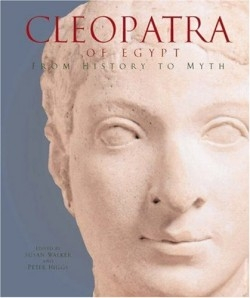Cleopatra of Egypt
From History to Myth
Who was Cleopatra, really? An intellectual stateswoman? An alluring seductress? A living deity? A greedy manipulator? An incestuous hedonist?
Cleopatra VII, daughter of the line of Ptolemy, deliberately promoted all these impressions of herself, and people today find her just as mesmerizing as her subjects did in ancient Egypt. Few artifacts survive directly from her lifetime, and, although much has been written about the queen and her reign in the subsequent centuries, many questions remain.
This hefty, intelligent book attempts to pin down the elusive identity and mysterious story of the fascinating woman who ruled Egypt from 51-30 B.C. It is the companion catalogue to a mammoth exhibit devoted to Cleopatra, at the British Museum in London and, later, at the Field Museum in Chicago.
The editors have collected essays by leading international scholars to explain the pieces of the exhibit in their historical and cultural contexts. Walker, Deputy Keeper in the Department of Greek and Roman Antiquities at the British Museum, is the lead curator of the exhibit and the author of several books on ancient art. Her colleague, Higgs, is Curator in the same department, specializing in later Classical and Hellenistic Greek sculpture. Both editors contributed essays to the catalogue.
The exhibit’s curators have assembled from across three continents every probable existing likeness of the Queen of the Nile, including eight that are newly authenticated, from period coins, jewelry, and statues to Renaissance paintings to Cecil B. DeMille’s publicity pressbooks. Notable in both the show and the book are pieces of art that contain written words, from ancient engraved stela and a royal taxation ordinance—written in Cleopatra’s own hand on papyrus—to references from Shakespeare and T.S. Eliot, to a new work called “Cleopatra’s Marriage Contract III,” drawn on handmade paper specially for the exhibition.
Well-educated and articulate (she probably spoke ten languages), petite and voluptuous, Cleopatra took the throne of Egypt at age eighteen, married two of her brothers in succession (this was typical of Macedonian royal families), and ruled by divine right for twenty-one years. She proclaimed herself a living manifestation of the mother goddess Isis, in part to maintain the loyalty of the powerful clergy. By all accounts, Cleopatra was the original drama queen, staging spectacular events both hedonistic and political.
As a descendant of Ptolemy, she was essentially Greek, and shrewdly allied her country with the Roman Empire by allying herself sexually with both Julius Caesar and Mark Antony. When she bore Caesar’s son, she issued a coin with an image of herself as Aphrodite nursing Eros. Later, she minted an unusual coin showing herself on one side and Antony on the other, with the two profiles looking extraordinarily similar. It is now thought that Antony and the queen used these coins to declare their true love, and to fix their couple-hood in the minds of all of the ancient world.
Cleopatra wore a diadem with three cobras, symbols associated with Isis. Historians have drawn on this distinctive crown when identifying which works of art actually portray Cleopatra, including a remarkably preserved black basalt statue previously thought to represent another Ptolemaic queen. When Cleopatra committed suicide, after the Roman emperor Octavian had crushed her attempt to rule the world with Antony, it seems much more likely that she used a cobra rather than an asp, because the cobra was her royal attribute, and because its poison would have been more swift, affording her a dramatic death tableau.
The book’s subtitle summarizes its structure, tracking the transformation of a mortal woman who lived in a tumultuous time into an immortal figure larger than myth. Each section is followed by a catalogue of pieces from the exhibition that illustrate it; each piece is described and interpreted in scholarly detail, using numbering systems that are sometimes confusing.
Part I establishes the history and culture of the fertile Nile region that gave Cleopatra her birth. The second section describes the queen’s religious strategy and her various images. Part III attempts to portray, as accurately as possible, the physical appearance of the queen, and her power struggles with Octavian. Finally, the last portion illustrates Egyptian influences in Italy, and the myriad ways that subsequent cultures have regarded and depicted the lady and her legend. Predictably, Renaissance artists favored images of Cleopatra as a romantic figure, depicting her hedonistic banquets, her dalliances with Antony, and her sensational death.
The catalogue provides maps, a chronology, a glossary, and a bibliography, all useful and thorough. It is the book’s color plates and illustrations, however, that give it life, an energy as forceful, as vivacious, and as fascinating as Cleopatra herself has been for twenty-one centuries.
Reviewed by
Karen McCarthy
Disclosure: This article is not an endorsement, but a review. The publisher of this book provided free copies of the book to have their book reviewed by a professional reviewer. No fee was paid by the publisher for this review. Foreword Reviews only recommends books that we love. Foreword Magazine, Inc. is disclosing this in accordance with the Federal Trade Commission’s 16 CFR, Part 255.

